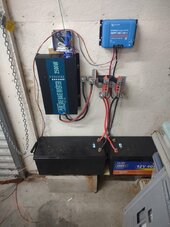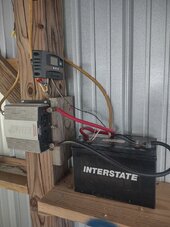Whats-n-Watts
New Member
Greetings all. Over the weekend I got my first system finished and got another installed enough for testing. Y'all may have taught me just enough to be dangerous of no fault of your own lol.
The interstate battery system was very simple. It's minimum use but was needed all the same due to no power at my shelter.
I installed six dc bulbs coming in at 7 watts each. I have two outlets 120vac powered by a 1,500 watt continuous duty inverter. It will never see much action especially a heavy load.
I installed 100w of solar through a 30 amp pwm controller. Before and after the controller I installed an automotive 10 amp blade fuse and a 5 amp blade fuse for the dc lighting. I didn't install any protection for the inverter to battery as it will never be on unattended anyways. Switched on and off as needed. Again a very light use little system mainly
for lights. The battery is an 80 ah deep cycle marine battery.
The next system (larger) is to power my shop. I have small power needs there. Charging power tool batteries and 226 watts of lights would be typical. I am also installing d/c lighting so the a/c will only be used should I need more light. The heaviest load this system will see is a 15 amp 10" table saw at 10 minute increments at the most.
I have a 50 amp scc as you can see and its fed by two 300 watt panels in series.
I have a 3rd panel and if needed will add another 50 amp scc and 600 watt of pv but I don't think it will be needed.
I used the guts from a new "free" meter base I got from the power company long ago before deciding to just drop some solar in.
I don't have my breakers yet and this was just a test run. I got duked by China and my so-called 12v 400ah batteries tuned out to be 12v 136ah. Yeah that hit hard in the feelings but I learned a lesson. They were $369 each and I hope they do okay.
I am posting so if you guys with way more knowledge on solar can tell me if I am on the right track or not as well as to ask you if you see any potential problems with what I have set up here. I have the batteries as well as pv disconnecting when I am not present for obvious reasons, no breakers or disconnects which are ordered.
Thanks to all for your help and input in advance.
The interstate battery system was very simple. It's minimum use but was needed all the same due to no power at my shelter.
I installed six dc bulbs coming in at 7 watts each. I have two outlets 120vac powered by a 1,500 watt continuous duty inverter. It will never see much action especially a heavy load.
I installed 100w of solar through a 30 amp pwm controller. Before and after the controller I installed an automotive 10 amp blade fuse and a 5 amp blade fuse for the dc lighting. I didn't install any protection for the inverter to battery as it will never be on unattended anyways. Switched on and off as needed. Again a very light use little system mainly
for lights. The battery is an 80 ah deep cycle marine battery.
The next system (larger) is to power my shop. I have small power needs there. Charging power tool batteries and 226 watts of lights would be typical. I am also installing d/c lighting so the a/c will only be used should I need more light. The heaviest load this system will see is a 15 amp 10" table saw at 10 minute increments at the most.
I have a 50 amp scc as you can see and its fed by two 300 watt panels in series.
I have a 3rd panel and if needed will add another 50 amp scc and 600 watt of pv but I don't think it will be needed.
I used the guts from a new "free" meter base I got from the power company long ago before deciding to just drop some solar in.
I don't have my breakers yet and this was just a test run. I got duked by China and my so-called 12v 400ah batteries tuned out to be 12v 136ah. Yeah that hit hard in the feelings but I learned a lesson. They were $369 each and I hope they do okay.
I am posting so if you guys with way more knowledge on solar can tell me if I am on the right track or not as well as to ask you if you see any potential problems with what I have set up here. I have the batteries as well as pv disconnecting when I am not present for obvious reasons, no breakers or disconnects which are ordered.
Thanks to all for your help and input in advance.





